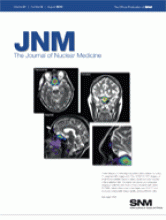Abstract
89Zr (half-life, 78.41 h) is a positron-emitting radionuclide that displays excellent potential for use in the design and synthesis of radioimmunoconjugates for immunoPET. In the current study, we report the preparation of 89Zr-desferrioxamine B (DFO)-J591, a novel 89Zr-labeled monoclonal antibody (mAb) construct for targeted immunoPET and quantification of prostate-specific membrane antigen (PSMA) expression in vivo. Methods: The in vivo behavior of 89Zr-chloride, 89Zr-oxalate, and 89Zr-DFO was studied using PET. High-level computational studies using density functional theory calculations have been used to investigate the electronic structure of 89Zr-DFO and probe the nature of the complex in aqueous conditions. 89Zr-DFO-J591 was characterized both in vitro and in vivo. ImmunoPET in male athymic nu/nu mice bearing subcutaneous LNCaP (PSMA-positive) or PC-3 (PSMA-negative) tumors was conducted. The change in 89Zr-DFO-J591 tissue uptake in response to high- and low-specific-activity formulations in the 2 tumor models was measured using acute biodistribution studies and immunoPET. Results: The basic characterization of 3 important reagents—89Zr-chloride, 89Zr-oxalate, and the complex 89Zr-DFO—demonstrated that the nature of the 89Zr species dramatically affects the biodistribution and pharmacokinetics. Density functional theory calculations provide a rationale for the observed high in vivo stability of 89Zr-DFO–labeled mAbs and suggest that in aqueous conditions, 89Zr-DFO forms a thermodynamically stable, 8-coordinate complex by coordination of 2 water molecules. 89Zr-DFO-J591 was produced in high radiochemical yield (>77%) and purity (>99%), with a specific activity of 181.7 ± 1.1 MBq/mg (4.91 ± 0.03 mCi/mg). In vitro assays demonstrated that 89Zr-DFO-J591 had an initial immunoreactive fraction of 0.95 ± 0.03 and remained active for up to 7 d. In vivo biodistribution experiments revealed high, target-specific uptake of 89Zr-DFO-J591 in LNCaP tumors after 24, 48, 96, and 144 h (34.4 ± 3.2 percentage injected dose per gram [%ID/g], 38.0 ± 6.2 %ID/g, 40.4 ± 4.8 %ID/g, and 45.8 ± 3.2 %ID/g, respectively). ImmunoPET studies also showed that 89Zr-DFO-J591 provides excellent image contrast, with tumor-to-muscle ratios greater than 20, for the delineation of LNCaP xenografts between 48 and 144 h after administration. Conclusion: These studies demonstrate that 89Zr-DFO–labeled mAbs show exceptional promise as radiotracers for immunoPET of human cancers. 89Zr-DFO-J591 displays high tumor–to–background tissue contrast in immunoPET and can be used to delineate and quantify PSMA-positive prostate tumors in vivo.
- immunoPET
- 89Zr
- prostate-specific membrane antigen (PSMA)
- J591
- monoclonal antibodies
- density functional theory
- © 2010 by Society of Nuclear Medicine







